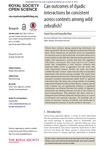Please use this identifier to cite or link to this item:
http://lib.hpu.edu.vn/handle/123456789/21675Full metadata record
| DC Field | Value | Language |
|---|---|---|
| dc.contributor.author | RoyTamal | en_US |
| dc.contributor.author | Bhat, Anuradha | en_US |
| dc.date.accessioned | 2016-06-25T01:57:02Z | |
| dc.date.available | 2016-06-25T01:57:02Z | |
| dc.date.issued | 2015 | en_US |
| dc.identifier.other | HPU4160295 | en_US |
| dc.identifier.uri | https://lib.hpu.edu.vn/handle/123456789/21675 | - |
| dc.description.abstract | Winner–loser relations among group-living individuals are often measured by the levels of aggressive interactions between them. These interactions are typically driven by competition for resources such as food and mates. It has been observed in recent studies on zebrafish that dominant males generally have higher total reproductive success than their less aggressive subordinate counterparts. | en_US |
| dc.format.extent | 8 p. | en_US |
| dc.format.mimetype | application/pdf | - |
| dc.language.iso | en | en_US |
| dc.publisher | The Royal Society | en_US |
| dc.subject | Biology | en_US |
| dc.subject | Behaviour | en_US |
| dc.subject | Ecology | en_US |
| dc.subject | Winner–loser | en_US |
| dc.subject | Aggression | en_US |
| dc.subject | Courtship | en_US |
| dc.subject | Zebrafish | en_US |
| dc.subject | Foodmonopolization | en_US |
| dc.title | Can outcomes of dyadic interactions be consistent across contexts amongwild zebrafish? | en_US |
| dc.type | Book | en_US |
| dc.size | 489KB | en_US |
| dc.department | Education | en_US |
| Appears in Collections: | Education | |
Files in This Item:
| File | Description | Size | Format | |
|---|---|---|---|---|
| 0178_Canoutcomes.pdf Restricted Access | 489.44 kB | Adobe PDF |  View/Open Request a copy |
Items in DSpace are protected by copyright, with all rights reserved, unless otherwise indicated.
